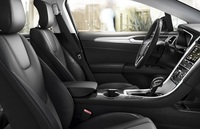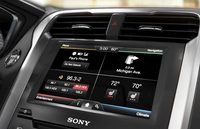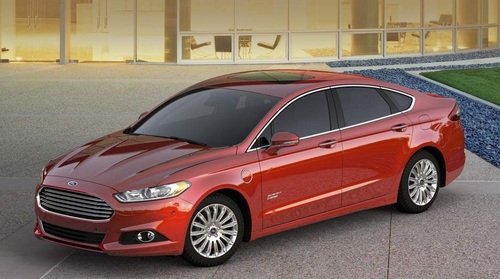Car Review: 2014 Ford Fusion SE And 2015 Ford Fusion Energi Reviews On The Auto Channel
THE AUTO PAGE
By John Heilig
Mid-Atlantic Bureau
The Auto Channel
Reviewed Models: 2014 Ford Fusion SE and 2015 Ford Fusion Energi
Engine: 1.5-liter I4 (Energi – 2.0-liter Atkinson Cycle I4)
Horsepower/Torque: 178 hp @ 6,000 rpm/177 lb.-ft. @ 1,500-4,500 rpm (Energi – 141 hp @ 6,000 rpm (188 hp total power)/129 lb.-ft. @ 4,000 rpm)
Transmission: 6-speed automatic (Energi - Electronic CVT)
Wheelbase: 112.2 in.
Length x Width x Height: 191.7 x 72.9 x 58.1 in.
Tires: P235/50R17
Cargo: 16.5 cu. ft. (Energi – 8.2 cu. ft.)
Economy: 26 mpg city/37 mpg highway/23.3 mpg test (Energi – 100 empg/43 mpg gas/50.3 mpg test)
Fuel capacity: 16.5 gal (Energi 14.0 gal)
Curb Weight: 3,427 lbs.
Sticker: $27,890 (includes $825delivery, $3,130 options) Energi - $44,620 (includes $795 destination, $5,125 options)
The Bottom Line: I find it hard to find fault with the Ford Fusion SE. It is roomy, it looks great, has decent power and hand ling and is a good price. The Fusion Energi delivers excellent fuel economy that would be even better with more care. But you can buy a lot of gas for the $17,000 bogey for high tech.
People always ask me how I like whatever car I’m driving for the week. To be honest, I love the Ford Fusion SE. It has just about everything you would want, except navigation and a rear view camera, which I’m certain could be added.
Blind spot monitoring is handled with conventional mirrors plus convex mirrors on the top outside quadrant of the outside rear view mirrors.
Fuel economy would, I’m certain, be better if some Interstate driving was included. However, we drove the SE almost exclusively on local roads. Oddly enough, we included a significant amount of Interstate miles while driving the Energi, which lowered our test mileage.
Both Fusions are nice drivers on all roads. Handling is very good. Power is surprising. It’s hard to believe that the SE had only a 1.5-liter four, with a healthy 178 horsepower. The Energi’s total power was 188 hp (141 of that coming from the 2.0-liter Atkinson cycle four). Both used automatic transmissions, a 6-speed in the Se and a CVT in the Energi. The Energi is also a nice driver/rider, with the unfortunate problem that exists with all hybrids of spending too much time looking at the fuel economy gauge. Ours got as high as 55.0 mpg before dropping down.
The SE is a “conventional” sedan, while the Energi is a plug-in hybrid. By that, Ford means it is a traditional hybrid in normal operation. Plug it in overnight, though, and you get 20 miles of pure electric power, with zero gasoline use. It’s like the Chevrolet Volt in that aspect. And that is why longer trips tend to reduce overall economy, while shorter, around-town, trips push overall economy numbers up.
With the exception of power, the two cars are essentially identical, with the exception of the trunk. Cargo capacity is a healthy 16.0 cubic feet in the SE, b ut a sparse 8.2 cubic feet in the Energi because of batteries located behind the rear seat backs. Also, Energi’s rear seat backs don’t fold. The SE’s trunk holds two golf bags. The week we had the Energi, our league had a 3-club challenge, so the lack of cargo capacity wasn’t a problem. There is a shelf in the Energi’s trunk that does add some cargo capacity.
 |
The SE has a clear instrument panel with the usual assortment of gauges. An information panel between the tachometer and speedometer has distance t empty, fuel economy and odometers. Energi’s instruments eliminate the tachometer and replace it with a conglomeration of what I call “hybrid gauges.” There is the all-important overall fuel economy, but you can also see how many miles are left of electric charge, and how effective you’ve been at keeping the batteries recharged by braking and downhill runs. It is possible to gain a mile or two of battery time by judicious braking.
 |
Both cars have capless fuel fillers and start/stop technology, where the engine shuts off whenever you’re sitting idle at a stop sign or traffic light.
Power the Fusion by coal and I’d probably still love it. In my mind it has everything. However, while economy figures for the Energi are impressive (and would have been more impressive if we had a stay-at-home week), $17,000 extra is a lot of money to spend just to be technologically up-to-date, even though you can get up to $7,500 in government rebates by going electric/hybrid. And, getting only 20 miles on electric is too little for the annoyance of plugging it in every night.
© 2014 The Auto Page



